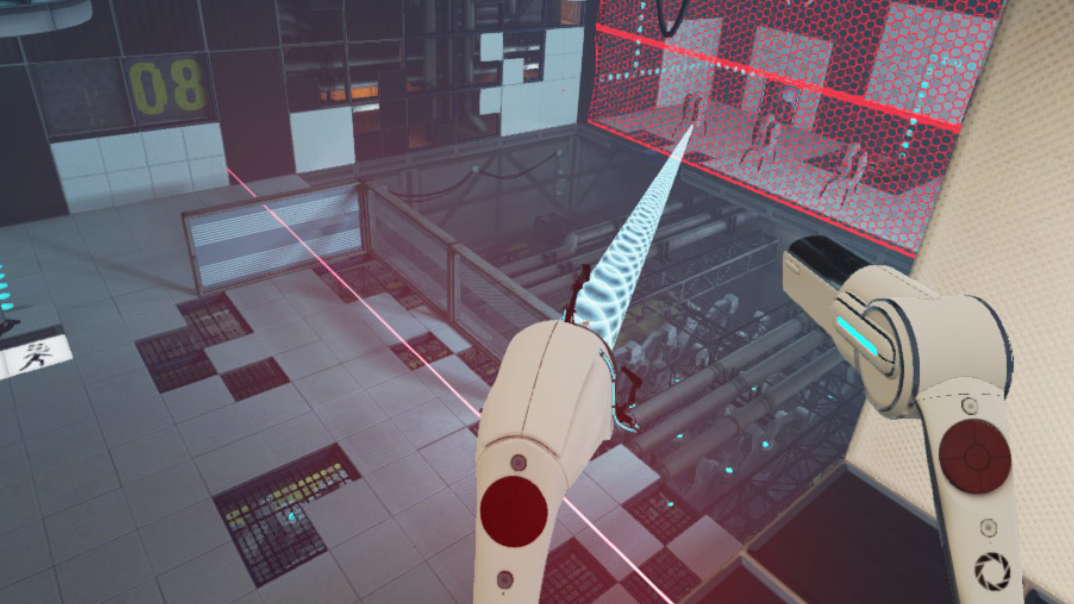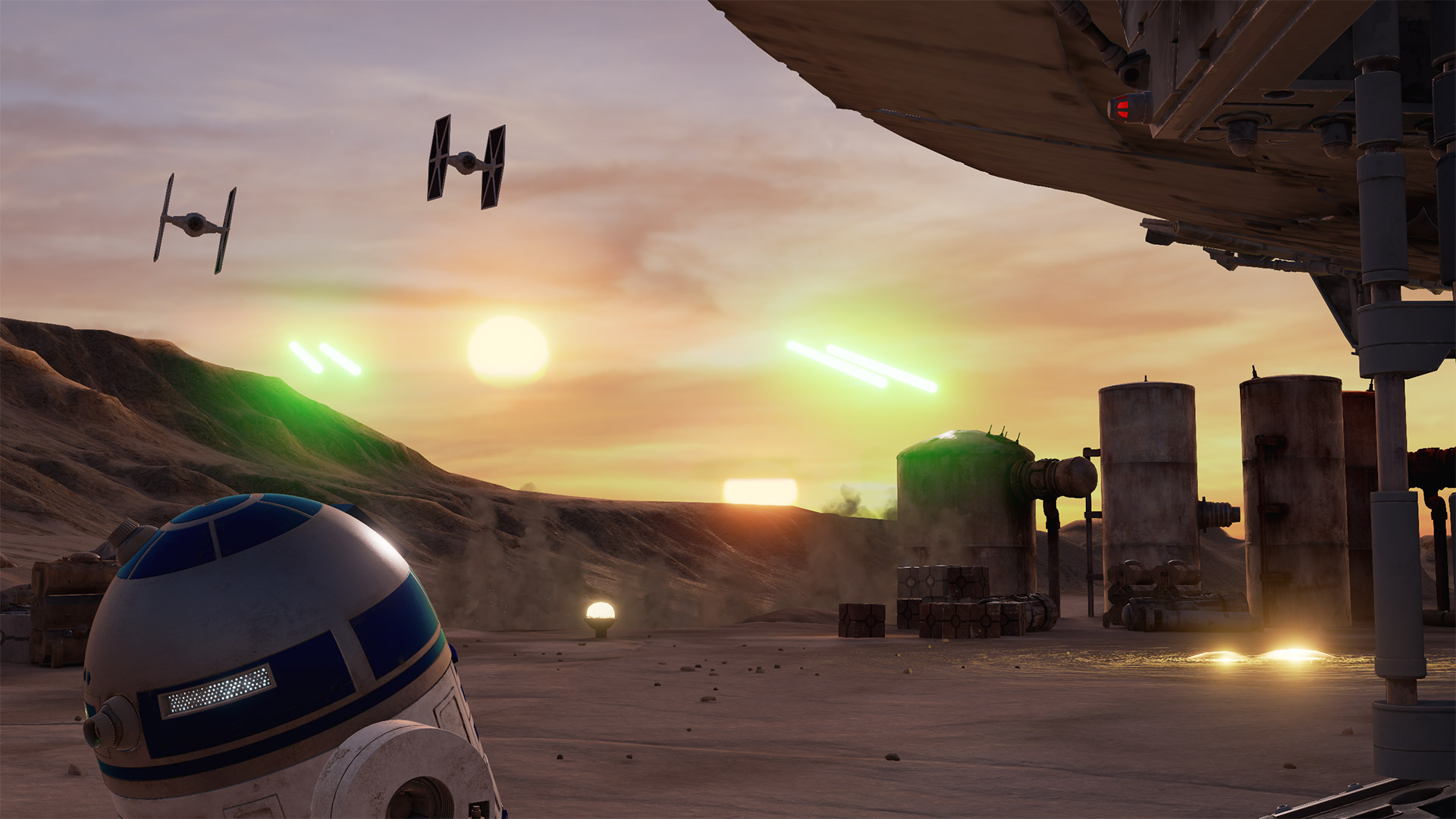My time with VR proves that it’s exciting tech that’s still first-gen.
Huge shoutout to Duff to start with for hooking Jamie and me up with an HTC Vive. As much as we’ve been going on and on about VR for literally years now, it means the world for to us to be able to experience it first hand.
Now that we’re immersed in the world of VR, here are some of my thoughts about the good, bad, and ugly of where VR is right now.
Almost everything about VR is cool. The good far outweighs the bad or the ugly. The first experience you have with a high-quality VR headset will drop your jaw, and that awe doesn’t wear off quickly.
Obviously one of the selling points of VR is the immersion. The HTC Vive, in my limited experience with the other options, delivers the best immersion, but Oculus and PSVR are not far behind. The idea of being surrounded by a virtual world is amazing, and he Vive controllers and room scale add another level of immersion.
One of my favorite immersive experiences was a table tennis game called Eleven: Table Tennis VR. I enjoy playing table tennis in real life, even though I’m not great. The Sexy Sidekick and I have a bit of a rivalry, of which she almost always wins. The visuals of the game are solid, but the amazing part was how real it felt to play. The physics felt spot on, down to the subtle haptic feedback of the Vive controller that made it feel like you were actually hitting a ping pong ball with a paddle.
The visual power of these first-gen headsets is also impressive. Of course, a lot of the performance depends on your computer, but the Vive consistently presented visuals that made me audibly gasp or giggle.
Project CARS is a great example of a game that shows off some of the visual power. I’m not a big car guy, but I geek out over Top Gear (or The Grand Tour) and dream about sitting inside one of those supercars. While it probably won’t ever happen for me in real life, sitting in a McLaren in VR is still a pretty amazing experience.
Many of my favorite moments in VR weren’t actually games. The new category of interactive experiences, which sounded pretty lame to me at first, has actually contained some of my go-to VR titles.
I love to travel and VR has already allowed me to explore new places. Google Earth in VR is really cool. Also titles like Destinations, which places you in old European castles or on the surface of Mars, are great ways to experience VR. theBlu is a title that puts you under the sea to observe marine life. While looking around doesn’t sound that compelling, it really is much more fun in VR that I could have ever imagined. There’s also a really cool VR movie-type-thing called Allumette that puts you as a floating head watching an emotional animated story play out all around you.
One last surprise perk to me about VR is how social it is. As Jamie and I discussed, it’s something that you want to share with others. The Sexy Sidekick got tired of me asking her to try different experiences. I was able to get my in-laws to try it out and watch their reactions. My mother-in-law even named the cute robot dog in The Lab “Dryer Vent”.
While VR is awesome, it is still obviously new tech. There are many places that you may be disappointed if you’re expecting a perfect experience at this young age.
One big issue is that there still isn’t a plethora of compelling software out there. I think the PSVR is probably doing the best on this front, but I also think developers are still trying to figure exactly what works and what appeals to gamers, especially those willing to buy into the technology this early.
A good example is the sheer number of VR titles on Steam that are in Early Access. As I’ve mentioned before, I’m not really into the idea of playing a game early. I’m willing to wait until it’s finished. I’ve made exceptions to that with VR mostly because a lot of the compelling software is still Early Access. There’s an archery title that was a blast, but its very limited still. In a year when a lot of these games are finished, the library will be stronger.
That’s not to say there aren’t great VR titles already. The Solus Project, Call of the Starseed, and Vanishing Realms are all great titles that are fleshed out. And there are small game experiences like Trials on Tatooine that show the future is promising.
Another early issue is figuring out the best control schemes for VR. The balance between navigation and immersion is tricky. For the Vive, room scale is an essential part of the experience, but it also leaves you reliant on the teleportation mechanic to get around. It actually works well in most cases, but can get difficult when you need to do something quickly. It ends up immersion breaking, which is a big issue for VR. I think that the evolution of the controllers, even with Oculus Touch, will steadily improve that issue, but I’m not sure it will ever be totally resolved.
And no matter what, controllers break immersion to a certain degree. I’ve actually really enjoyed the Vive controllers and felt they do a good job over all, but the have been several times that I’ve bashed them into each other while trying to do something with the headset on and not realizing the bulk of the physical controllers in my hands.
The headsets also have improvements to be made. Focus can be really difficult to get right, although I imagine this is different for each person. For me as a glasses-wearer, I’ve often wondered if someone without glasses has it easier, but reading reviews seem to indicate that everyone struggles to some degree.
Getting the headset on your head perfectly is vitally important. I spent a lot of time readjusting the headset to try to get a clearer image. It takes lots of tweaking to make it feel good – and it’s a constant process. And even when you get it feeling good, the peripheral focus is still difficult. Reading the text in some titles was a constant struggle.

To finish up, there are some serious issues with VR that may or may not be solvable.
Chief amongst these problems is the cable. Immersion is great until you suddenly tie yourself in a knot with the long trail of cable that is necessary to send visual and audio data to the headset. It is completely immersion breaking. Wireless technology for VR seems incredibly difficult, but it is necessary and something that the major companies are already working on.
Another issue I dealt with was motion sickness. A little background about my own susceptibility to motion sickness, as there is quite the spectrum of affliction levels. I get car sick relatively easy if I’m in the passenger seat or back seat. However, planes and busses don’t bother me a lot. I can’t read while traveling in a car, but am generally fine on a plane. I haven’t ever thrown up because of motion sickness, but the nausea can be crippling.
I was fine with most VR titles. However, a few made me sick pretty quickly. The biggest culprit was Adr1ft. It was a game I was really looking forward to. You play as a stranded astronaut orbiting earth. It’s a super cool experience, but I could only last for a few minutes before I was completely nauseous. It makes sense as the controls are so disorienting, but I was shocked to the level of discomfort it caused.
Lastly, a constant struggle with VR will be living in a real environment while interacting with a virtual environment. I ran into things, hit my ceiling fan with the Vive controllers, and nearly impaled myself on multiple occasions.
One example was playing the Portal Stories title, which is a blast in VR. At one point, a turret locked on to me, which caused me to react abruptly and violently by jumping directly into my TV stand. Luckily, I didn’t knock it off or break anything, but I easily could have. Sure, the boundary lines that are visible in the headset give you a reference point, but they are easy to ignore when you are in a firefight.

I firmly believe that VR is here to stay. The technology is fun and immersive. And it’s still very new, which means a lot of improvements are still to come. I’m still more interested in traditional gaming than VR, but VR is a wonderful supplement to this hobby I love so much.



